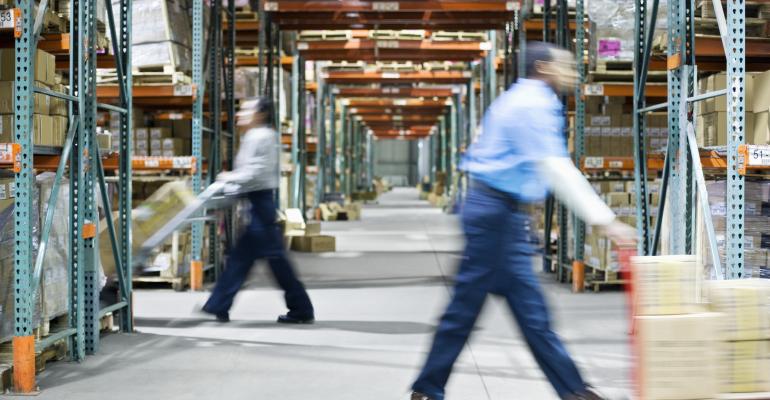The U.S. retail industry will have winners and losers in 2018, but third-party logistics (3PL) operators and the industrial sector will be on the winner list.
Today, the biggest challenge for brick-and-mortar retailers competing in the e-commerce space is speed of delivery, and commercial real estate brokers are working to help clients overcome that challenge, according to Garrick Brown, vice president of retail research for the Americas with real estate services firm Cushman & Wakefield.
Amazon’s logistics infrastructure includes 800,000 sq. ft. to 1 million sq. ft. of warehouse and distribution space outside every major U.S. city, Brown notes. Big retailers like Walmart and Target have the financial resources to acquire or build competitive logistics infrastructure on par with Amazon, but smaller retailers must rely on 3PL operators, including UPS, FedEx and the U.S. Postal Service, to help them compete in the e-commerce marketplace.
Last year, Walmart purchased Jet.com, one the fastest growing e-commerce retailers in the U.S., for $3.3 billion in cash and Walmart stock to improve its logistics capabilities. A few weeks ago Target inked a $550 million deal to acquire Shipt, a network of more than 20,000 personal shoppers that fulfill orders for various retailers. Company executives contend this move will bring same-day delivery service to about half of Target stores in 2018.
Retailers are also developing creative strategies to improve their logistics performance. Nordstorm, for example, is opening showrooms with inventory technology that will allow customers to order merchandise to be delivered the next day from a nearby warehouse or department store location.
“We will see concepts like this tweaked over the next few years,” Brown says. “Once these systems are in place and retailers create showrooms that attract consumers, we’ll see brick-and-mortar stores become more competitive with online retailers.”
Meanwhile, online retailers continue to expand into brick-and-mortar space, driven by the advantages of branding and experience physical stores offer. For example, the “clicks to bricks” transition provides these retailers with an advantage in dealing with returns, Brown notes—the Achilles’ heel of online sales, as shipping costs eats up profits. Online retailers have a 30 percent return rate, compared with a 10 percent return rate for brick-and-mortar retailers.
Returns, in fact, can serve as a boon for brick-and-mortar retailers, bringing customers back into stores and potentially generating additional sales, while online retailers have to pay 3PL services like Happy Returns to sell returns to discounters or distribute them to charities, or like Amazon, they have to pay for customers’ return shipping fees. Returns sold at discount or not resold are estimated to cost retailers 4.4 percent of total revenue each year, according to CBRE research.
A CBRE Market Flash report from David Egan, who heads the firm’s industrial & logistics research, Americas and Global, notes that 3PL operators and industrial facility owners are benefitting from the rapidly rising rate of product returns, as many retailers outsource their reverse logistics operations to cut costs and improve efficiency.
With 3PL space needs growing by 3 to 5 percent annually since 2013, Egan estimates these industrial users currently occupy 700 million sq. ft. of warehouse and distribution space in the United States.
Meanwhile, with the success of its brick-and-mortar bookstores, Amazon is expected to open more storefronts going forward. In addition, when this online retail giant acquired upscale grocer Whole Foods for $13.4 billion, the deal included a fleet of 460 physical stores, which Brown expects Amazon will expand, with the addition of smaller, 20,000-sq.-ft. to 30,000- sq.-ft. stores.
He notes that Amazon has acquired a pharmaceutical license in 17 states, with plans to enter the drugstore business. “This might be the next big real disruption,” Brown points out, noting that this license allows the company to begin selling medical devices and other related products. He suggests Amazon may eventually get into the prescription drug business, with the ability to provide next-day delivery.
Other online retailers plan to be moving into physical space in 2018 too. For instance, Indochino, an online men’s apparel retailer, has opened 10 stores and plans to open 30 more; Yogibo, an online new age furniture store, plans to open 10 -13 storefronts; Rent the Runway, an online retailer that rents out designer clothing, is adding physical stores; Fabletics, an online women’s athletic apparel concept by Kate Hudson, may open up to 20 storefronts; and Gilt, an online retailer that sells discounted designer apparel, is considering opening five to 10 stores.
“This string of brick-and-mortar store construction translates into an industrial ramp-up,” says Jason Tolliver, head of industrial research, Americas, with Cushman & Wakefield.
He also notes a sea change in how store retailers view logistics, with it becoming a revenue driver. “It is business, not just a cost center, and as important as the storefront.”
With logistics speed driving retail sales, retailers are expanding space in both distribution centers on the urban perimeter and in warehouses close to consumers, he says. “This is why industrial vacancy is so low,” Tolliver notes, adding that growth in the retail logistics sector will continue to be a boon for the industrial sector for the foreseeable future.

